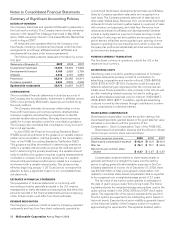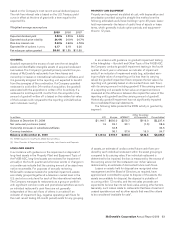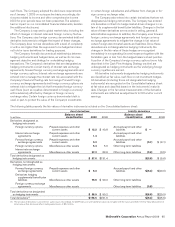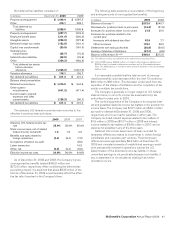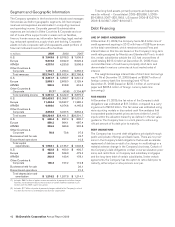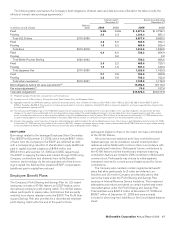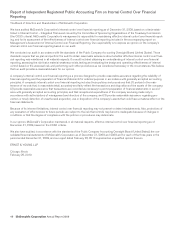McDonalds 2009 Annual Report Download - page 40
Download and view the complete annual report
Please find page 40 of the 2009 McDonalds annual report below. You can navigate through the pages in the report by either clicking on the pages listed below, or by using the keyword search tool below to find specific information within the annual report.
shares): 2009–15.2; 2008–19.4; 2007–23.5. Stock options that
were not included in diluted weighted-average shares because
they would have been antidilutive were (in millions of shares):
2009–0.7; 2008–0.6; 2007–0.7.
The Company has elected to exclude the pro forma deferred
tax asset associated with share-based compensation in net
income per share.
STATEMENT OF CASH FLOWS
The Company considers short-term, highly liquid investments with
an original maturity of 90 days or less to be cash equivalents.
SABBATICAL LEAVE
In certain countries, eligible employees are entitled to take a paid
sabbatical after a predetermined period of service. In 2006, the
FASB issued guidance on accounting for sabbatical leave, codi-
fied in the Compensation – General Topic of the FASB ASC.
Under this guidance, compensation costs associated with a
sabbatical should be accrued over the requisite service period,
assuming certain conditions are met. The Company adopted the
guidance effective January 1, 2007, as required and accordingly,
recorded a $36.1 million cumulative adjustment, net of tax, to
decrease beginning retained earnings in the first quarter 2007.
The annual impact to earnings is not significant.
SUBSEQUENT EVENTS
In May 2009, the FASB issued guidance on subsequent events,
codified in the Subsequent Events Topic of the FASB ASC. This
guidance sets forth the period after the balance sheet date dur-
ing which management of a reporting entity should evaluate
events or transactions that may occur for potential recognition or
disclosure in the financial statements. The guidance also
indicates the circumstances under which an entity should recog-
nize events or transactions occurring after the balance sheet date
in its financial statements, as well as the disclosures that an
entity should make about events or transactions that occurred
after the balance sheet date. The Company adopted this guid-
ance beginning in the second quarter 2009. The adoption had no
impact on our consolidated financial statements, besides the
additional disclosure.
The Company evaluated subsequent events through the date
the financial statements were issued and filed with the Securities
and Exchange Commission, which was February 26, 2010. There
were no subsequent events that required recognition or dis-
closure.
Property and Equipment
Net property and equipment consisted of:
In millions December 31, 2009 2008
Land $ 5,048.3 $ 4,689.6
Buildings and improvements
on owned land 12,119.0 10,952.3
Buildings and improvements
on leased land 11,347.9 10,788.6
Equipment, signs and seating 4,422.9 4,205.1
Other 502.4 516.8
33,440.5 31,152.4
Accumulated depreciation
and amortization (11,909.0) (10,897.9)
Net property and equipment $ 21,531.5 $ 20,254.5
Depreciation and amortization expense related to continuing
operations was (in millions): 2009–$1,160.8; 2008–$1,161.6;
2007–$1,145.0.
Discontinued Operations
The Company previously operated Boston Market in the U.S.,
which it sold in August 2007. As a result of the disposal, Boston
Market’s results of operations and transaction gain are reflected
as discontinued operations. In connection with the sale, the
Company received proceeds of approximately $250 million and
recorded a gain of $68.6 million after tax. In addition, Boston
Market’s net loss for 2007 was $8.5 million. Boston Market’s
results of operations for 2007 (exclusive of the transaction
gains), which previously were included in Other Countries &
Corporate, consisted of $444.1 million of revenues and a pretax
loss of $17.0 million.
Latam Transaction
In August 2007, the Company completed the sale of its busi-
nesses in Brazil, Argentina, Mexico, Puerto Rico, Venezuela and
13 other countries in Latin America and the Caribbean, which
totaled 1,571 restaurants, to a developmental licensee orga-
nization. The Company refers to these markets as “Latam”. Based
on approval by the Company’s Board of Directors on
April 17, 2007, the Company concluded Latam was “held for
sale” as of that date in accordance with guidance on the impair-
ment or disposal of long-lived assets. As a result, the Company
recorded an impairment charge of $1.7 billion in 2007, sub-
stantially all of which was noncash. The total charges for the full
year included $895.8 million for the difference between the net
book value of the Latam business and approximately
$675 million in cash proceeds received. This loss in value was
primarily due to a historically difficult economic environment
coupled with volatility experienced in many of the markets
included in this transaction. The charges also included historical
foreign currency translation losses of $769.5 million recorded in
shareholders’ equity. The Company recorded a tax benefit of
$62.0 million in connection with this transaction. The tax benefit
was minimal in 2007 due to the Company’s inability to utilize
most of the capital losses generated by this transaction. As a
result of meeting the “held for sale” criteria, the Company ceased
recording depreciation expense with respect to Latam effective
April 17, 2007. In connection with the sale, the Company agreed
to indemnify the buyers for certain tax and other claims, certain of
which are reflected on McDonald’s Consolidated balance sheet
(2009: other long-term liabilities–$71.8 million; accrued payroll
and other liabilities–$25.3 million; 2008: other long-term
liabilities–$141.8 million). The change in the total balance was
primarily a result of the resolution of certain of these liabilities as
well as the impact of foreign currency translation. The Company
mitigates the currency impact to income of these foreign cur-
rency denominated liabilities through the use of forward foreign
exchange agreements.
The buyers of the Company’s operations in Latam entered
into a 20-year master franchise agreement that requires the
buyers, among other obligations to (i) pay monthly royalties
commencing at a rate of approximately 5% of gross sales of the
restaurants in these markets, substantially consistent with market
38 McDonald’s Corporation Annual Report 2009






